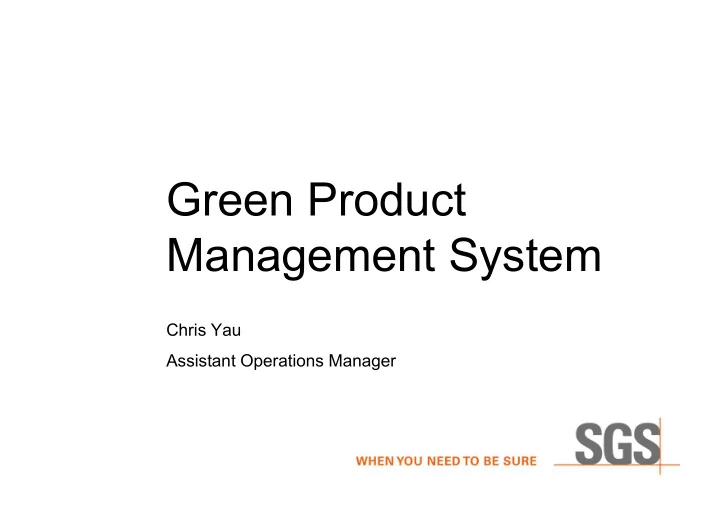

Green Product Management System Chris Yau Assistant Operations Manager
What is a green product? � Type 1, Seal of approval (ISO 14024) � Type 2, Self-declared (ISO 14021) � Type 3, Life cycle based (ISO 14025) 2
3 WEEE Waste Treatment RoHS Waste Collection EuP Reuse Recycle Recovery Product in Use LCA Considerations RoHS, 76/769 + others Distribution Packaging GPMS Design Assemble Manufacturing WEEE RoHS EuP Product Design Extraction
Even big corporation made mistakes! Supply chain management 4
Ignorance leads to errors � “We are very lucky. I have gone through the lengthy list and didn’t find anything… “ � “We have supplier guarantees and all our suppliers are customer approved…” � ICP reports • heavy metal tests, no organic substances coverage � PBB, PBDE reports on metals • Metals were never present in PBB, PBDE � Fake WEEE / RoHS compliance certificates Staff Awareness 5
Customers requirements are complicated! Cd Pb Hg Cr6 PBB PBDE Reference Sony 5* 100* 0 0 SS-00259 Mircosoft 25 100 5 100 100 H00594 Panasonic 75 100 100 100 0 Ver 3 Motorola 100 100 100 100 100 GS2257 NEC 100 0 0 0 Ver 2 IBM 100 1000 10 1000 ES45G3772 TCO 2 50 2 0.5% HFR Ecology Checklist Batteries 250 400 250 91/157/EEC Packaging 100 100 100 100 94/62/EEC Paints, Plastic and Stablizer 50 300 100 89/677/EEC ELV 100 1000 1000 1000 2000/53/EEC RoHS 100 1000 1000 1000 1000 1000 2002/95/EEC Good customers / legal requirements management 6
Sustainability development � 5th Environmental Action Program � Global warming � Ozone layer depletion � Resources depletion � etc Design for environment 7
Scope of GPMS � An effective Green Supply Chain Management � A structured Staff Awareness Program � A Good Legal and Customer Requirements Management mechanism � Environmental conscious Product Design 8
Green Supply Chain Management � Identification and prioritization of client environmental requirements � Green Procurement � Green BoM and database development & maintenance � Supplier education and partnership � Enhanced receiving inspection � Chain of custody management 9
Design for environment � Material considerations • Material intensity • Toxic, Banned, Restricted Substances • Recycled, renewable materials • Recyclability, Recoverability • Ease of disassembly � Energy use considerations • Energy intensity • Renewable energy � Life cycle considerations • Life cycle environmental impacts • Long lasting and durable 10
Awareness Development � Understanding in principle the importance of sustainable development � Understanding on the requirements stipulated in WEEE / RoHS / EUP and customers � Understanding on potential contamination of green products � Establishment of eco-design as part of corporate design objectives and requirements � Awareness on sources and routes of restricted and banned substances � Supply chain education � Follow up and updating developments in WEEE / RoHS / EUP and related legislations 11
GPMS Certification 12
MSDS Management � Create a MSDS according to EU Directive 2001/58/EC 13
Environmental / Sustainability Reporting Verification 14
Recommend
More recommend